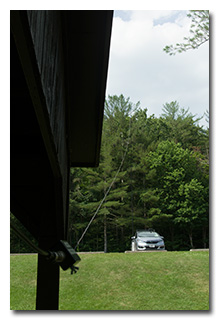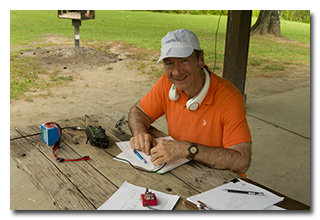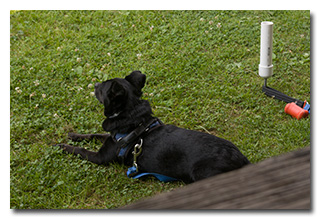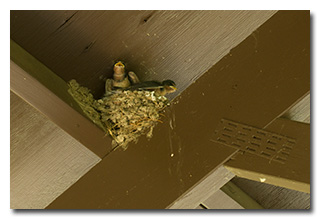
by William Eric McFadden
From the Strouds Run State Park website:
-
Located outside of the city of Athens and within easy driving distance of Ohio University, Strouds Run State Park surrounds Dow Lake and draws a mix of trail and lake users. Miles of hiking, mountain biking, and horseback riding provide scenic views from rugged trails. The lake offers boating, paddling, swimming and a shaded campground.
Pictures
Description
On Saturday, June 22, 2024, one member of the Southeast Ohio Radio Adventure Team performed a successful activation of Strouds Run State Park (US-1994) as part of the Parks on the Air (POTA; link).
On a brutally hot and humid afternoon, after helping Athens County Amateur Radio Association (ACARA) set up for ARRL Field Day (link) and verifying that all the stations were manned, Eric McFadden, WD8RIF, went to Strouds Run State Park for a quick personal ARRL Field Day operation and a POTA activation of the park. Eric was joined by Len Touth, W8VQ, whom Eric had know back in the 1990s through the Columbus QRP Club, but who had dropped out of Amateur Radio for about twenty years and was just getting back into the hobby. (Long-time readers might remember that Len was involved in the Southeast Ohio Radio Adventure Team's 1997 Freeze Your B___ Off event.) Eric and Len were joined by Eric's little POTA-pup, Theo.
Eric, Len, and Theo arrived at Bulldog Shelter at about 1930 UTC. Because of the extreme heat, they were very happy to find the picnic shelter to be unoccupied and available for their use. Choosing one of the well-shaded picnic tables at one end, Wanting to have the best antenna possible for this quick Field Day operation, Eric deployed his homebrew 40m end-fed halfwave (EFHW) antenna as a sloper from the picnic shelter up to the top of his 31' Jackite telescroping fiberglass mast held upright on a drive-on base. Len had expressed interest in seeing both of Eric's premium field transceivers, so Eric set up his Elecraft KX3 on the picnic table. Eric had brought a laptop PC configured with N1MM Logger+ but, since he didn't plan to operate very long, he decided to log (and dupe) to paper. Eric was on the air at 1950 UTC.
Because Eric planned to operate a straight ARRL Field Day operation in class 1B, Eric didn't need the available cell-signal or the availability of the POTA Spots (link) website.
When they had left the ACARA Field Day operation, conditions on the HF bands had been rough and, very surprisingly, signals were sparse on 20 and 40m. This is one reason Eric had decided to deploy the 40m EFHW antenna instead of his usual 28½' random wire vertical—he wanted the best possible antenna to increase his chances of quickly getting ten QSOs for a valid POTA activation. Eric began his operation on the very bottom of the 40m band and began slowly tuning up the band. His first QSO came 1952 UTC with W4IY in Virginia. Eric was surprised that signals were plentiful and he was able to work most of the stronger stations with just a single call. Eric made his eleventh QSO at 2015 UTC, with K3PAX in Maryland/DC. This run included QSOs with Field Day operations located in the ARRL/RAC sections of Virginia (2), Southern New Jersey, Ohio (2), Illinois, Great Horseshoe, Maryland/DC (2), and Eastern Pennsylvania (2).
Just to test conditions on 20m, Eric started tuning that band up from the very bottom and in five minutes he made three QSOs with stations located in the ARRL sections of Northern Florida, South Texas, and Arizona.
When it was time to offer a Len a rig, Eric gave him the choice of the KX3 or the KX2. He chose the KX2. Len had brought with him his field-antenna from the 1990s, a Hustler mobile mast on a three-magnet base with resonators for several bands. Eric offered his the three 17' counterpoise wires from his 28½' end-fed wire antenna, which Len connected to the magnetic base, magnetically. Len installed a 40m resonator and placed the whole antenna system on the grass.
Len made a few contacts with the KX2 and the Hustler antenna, but he had a fair amount of difficulty. Switching to the 40m EFHW, he found greater success, and within just a few more minutes, he validated his first-ever POTA activation with ten QSOs plus a spare for good measure.
Len was very impressed with both the KX3 and the KX2 and during station tear-down, he and Eric discussed the merits of each. For his part, Eric was very impressed by Len's CW skills, considering that Len has been off the air the past two decades.
In all, Eric logged fourteen QSOs, and Len logged eleven QSOs. Both operators used only CW and all QSOs were made at five watts output.
Eric also submitted his log to the World Wide Flora and Fauna in Amateur Radio (WWFF; link) program for an operation at Strouds Run State Park, KFF-1994.
(return)



